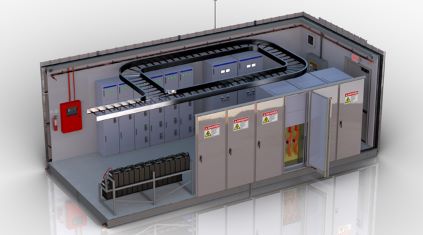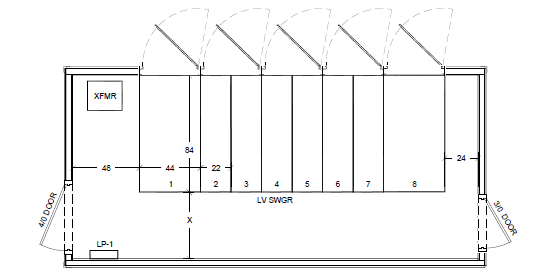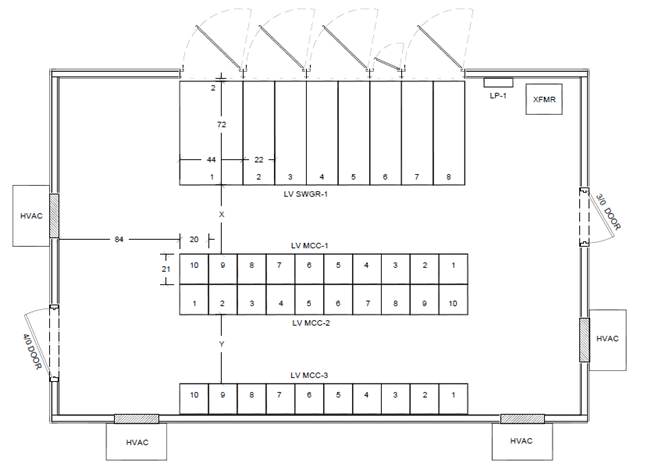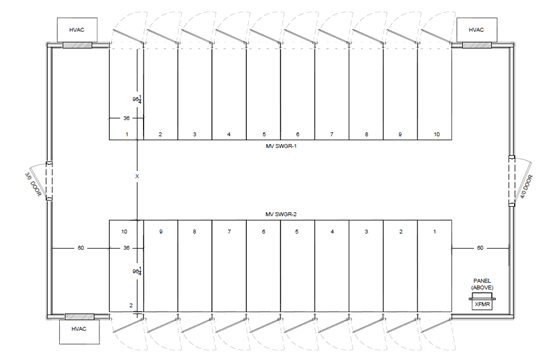CLEARANCE AND EGRESS CHANGES IN THE 2023 NEC

Concerns: Revised National Electrical Code (NEC) egress clearance requirements can exceed working space requirements, potentially causing e-houses to increase in size during the design phase to meet the egress code language.
Engineers and end users are continually requesting e-houses with more equipment integrated inside, and “Mega” e-house applications are on the rise. Trachte Application Engineers optimize your layouts based on the space needed for high-valued electrical equipment, as well as considerations for code-related working clearance and egress paths for life-safety concerns.
- In the 2020 NEC, section 110.26(C)(2)(2) stated that “Open equipment doors shall not impede the entry to or egress from the working space”. This language was not included in the 2017 NEC and requires the designer to allocate space based on the greater of either the width of an open-door on the equipment plus the 24” egress path, or the required working space, which is based on conditions listed in NEC 110.26(A)(1) or 110.34(A), depending on voltage class (Conditions 1, 2 or 3).
- The 2023 version of the NEC moved this language to the main section of 110.26 and states, “Open equipment doors shall not impede access to and egress from the working space. Access or egress is impeded if one or more simultaneous opened equipment doors restrict working space access to be less than 610 mm (24 in.) wide and 2.0m (6-1/2 ft) high.” This language is repeated in section 110.33 for equipment over 1,000 volts, nominal.
Trachte interprets this new code language to mean when equipment is designed to be “across the aisle” from each other, space must be allocated to allow the widest doors on each side to be open, while also including a 24” egress path between the open doors. In many applications under 600 VAC, this new language will force the equipment to be installed further apart than previous NEC versions allowed for, especially under Condition 3 in Table 110.26(A)(1). This new code requirement will cause many e-house applications to expand in size, as the space between electrical equipment expands to meet the 2023 NEC.
For most MV applications complying with NEC Condition 1 or Condition 2, this will not have much or any impact, yet at Condition 3, the space will most likely expand from previously allowed code values.
Please see the following examples showing the impact of the 2023 NEC changes versus 2017 and 2020 allowable values.
Example 1 – 480 VAC Switchgear, Condition 2 with no electrical items on opposing wall


- * 2017 NEC requires 42” per 110.26(A)(1), yet the NEC requires the doors to open at least 90 degrees and since the largest door is 44” wide, the 44” value was used for this example. Trachte would have typically applied at least a 48” aisle in this situation.
- If the manufacturer can provide split front access doors or provide removable covers, these issues can be mitigated.
- The application shown above is for Condition 2 in Table 110.26(A)(1), considering the e-house wall as “grounded parts”. Further examples with Condition 3 follow.
- As front access doors vary in size, the space in front of the gear will need to be adjusted as well. As an example, if the door on VS 1 was 48” wide, the space would need to be 72” under 2023 NEC.
Example 2 – 480 VAC Switchgear with 480 VAC MCC lineups, Condition 3 and center aisles between equipment


- The design assumption is that the LV MCC has 16” wide doors.
- Based on the 2023 NEC, the space between LV SWGR-1 and LV MCC-1, (X) is shown at 84”, based on the 44” LV SWGR-1 door open and a 16” LV MCC-1 16” door open, plus the required 24” egress path space.
- If the LV SWGR can be physically moved over to the left in the plan view by the width of the door on VS1 (44”), or the LV MCC-1/LV MCC-2 line ups can be shifted to the right, the required clearance at (X) is reduced to 62” based on the doors on LV SWGR-1, VS 2-8 at 22” wide and the doors on the LV MCC at 16” wide, adding in the 24” egress space requiring 62” instead of 84”, and allowing the overall width of the e-house to be reduced by almost 2’.
- To comply with the 2023 NEC, the space, (Y) between MCC 2 and MCC 3 is 56”, based on doors open on each MCC at 16” wide, plus the 24” egress path between the open doors. Previous versions of the NEC allowed that space to be 48” since the working clearance requirements exceeded the egress requirements in the 2020 NEC.
Example 3 – Medium Voltage Switchgear, Condition 3, with center aisle


- Most 5kV applications under 2020 NEC allowed for 60” of space as the center aisle, using 36” for the open door and a 24” egress path based on the language in section 110.26(C)(2)(2) for egress, or using values in Table 110.34(A) for Working Space. At 15kV, the 2023 change increases the center aisle by 2’ and at 38kV, this center aisle goes from 9’ to 12’.
- If the medium voltage gear sections increase in width, the center aisle needs to grow based on door sizes and the 24” egress path and not the Working Space values in Table 110.34(A). As an example, if the vertical sections are 42”, and the voltage is 5kV, the center aisle would increase from 96” to 108”.
- If your application has one end section that is wider than the other sections in the lineup, it is suggested that the lineups be offset so the wider vertical section is not opposite the other lineup, similar to the LV SWGR Example 2, above.
- Please note that many switchgear manufacturers define the minimum space needed in an aisle or in front of the gear if using a breaker lift truck. Please follow all manufacturer’s spacing requirements unless the code in effect requires more.
TRACHTE IS YOUR DEDICATED COMPLIANCE TEAM
Trachte Application Engineers and Designers use industry best practice to design an e-house layout that optimizes the cost for your project needs, while including adherence to complex code compliance.
Our dedicated Compliance Control team continuously monitors the adoption, as well as the pending adoption, of NEC versions by state. Based on current lead times for large e-house projects with complex electrical equipment, our team is constantly reviewing these code adoption trends so the designs we help you develop today will be compliant in the future as the project develops, requiring state and potentially local approval.
For more information on this important code change or any other e-house application issues, please reach out to your Trachte account representative to discuss the specifics of your project.
Questions?
Rob Chaffee
Executive Director of Integrated Packaging
864-906-8280 | rchaffee@trachteusa.com
Note: The information provided in this document is for reference only and is neither meant as a code document nor does it supersede any specific code requirements that are applicable in your region. As always, please consult with your project engineering team, as well as the AHJ for your location, to determine specific requirements that may apply. Trachte assumes no liability in sharing this information for reference.

